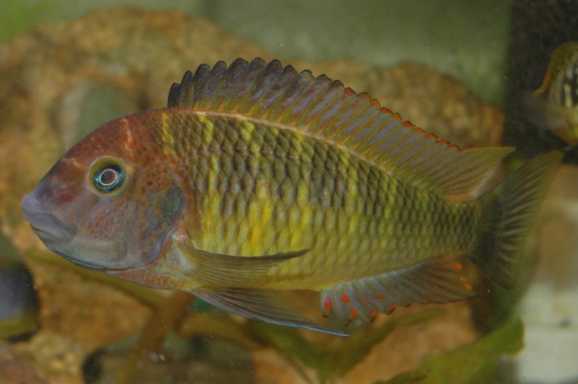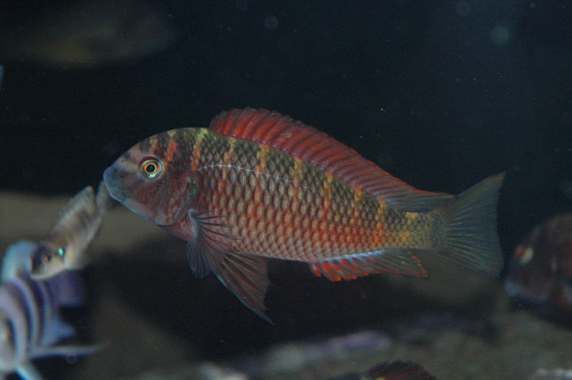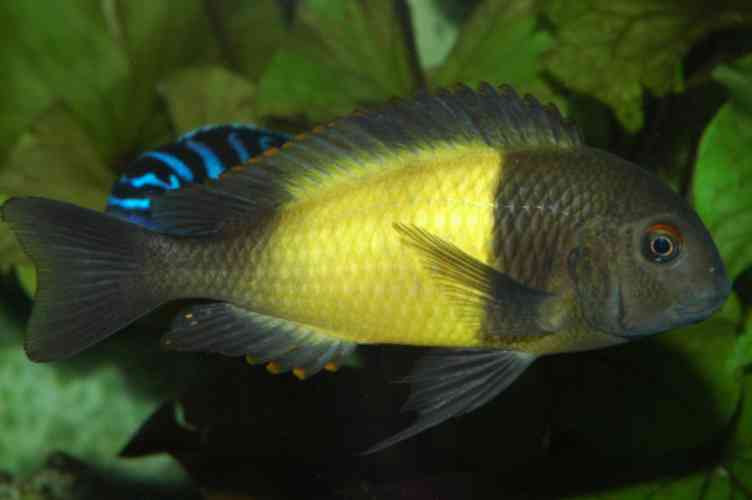Tropheus are vegetarian in nature and possess an extremely long digestive tract. They can be found grazing epiphytes, algae and other tiny zoological organisms off rocks and plants. They are also extremely territorial and will defend their grazing areas from competitors. Because of their dependence on their local grazing areas, they will not venture very far from their rocky outcroppings and can spend their entire lives in a relatively tiny area around a reef, or island. For this reason, they have developed an interesting social behavior not found in other species.
Once a local population is geographically isolated by any number of abiotic or biotic factors, shattering their primordial rocky habitat into smaller domains, genetic drift and other slight mutations may cause the evolution of two or more races, eventually developing into the diversity we see today. Abiotic factors include coastal erosion or silt runoff, whereas biotic factors include predation.
No matter which species we acquired, we always started with bare minimum of at least six individuals, though with hindsight, eight was a better number. The one inch fry were immediately placed into a large community tank with plenty of algae covered rockwork, and we have never lost a single fry to predation. Over time we have culled extra individuals, especially males, and allowed the next generation to recruit into the colony.
There does not appear to be a magic male to female ratio, but experience have taught us that keeping a single male and two females was almost impossible and keeping a single male and single female was very difficult. Thus for success, any colony needs to have at least one male and three females, and if there is a fifth individual, it should be a male. The reasons are as follows. With only one female, she will be constantly harassed by the male, especially while carrying eggs and active management is required. With two females, the smallest, weakest female will be harassed by both the male and a very aggressive, mouth brooding dominant female. As for keeping an extra male, they give each other a little competition, forcing the dominant male to show his best colors. In addition, the subordinate male's territory also serves as a safe haven for females from the dominant male. Be warned, the subordinate male may not always be in very good condition and may lose crucial territorial battles.
On the other hand, having too many individuals within a limited space will also lead to deaths. Hyperdominance, a useful behavior trait for keeping a very dense population of Malawi Mbunas within a limited space does not seem to work for Tropheus. For Mbunas, hyperdominance prevents the establishment of a single dominant male, but Tropheus, being extremely territorial and naturally dependent on their grazing areas, will fight to protect their meager patches of algae. Once a fish loses and stops eating, there is a danger of bloat setting in.
Whatever the cause, being bad water quality, rotting food, or simply introducing an infected fish, Malawi Bloat is by far the most dangerous illness a fish can get. In simplest terms, bloat is a condition in which the fish retains fluid as if suddenly placed within a hypertonic solution, expands like a balloon and dies from the intense outward pressure, rupturing internal organs. All this occurs within two or three days and is extremely contagious. Other visible symptoms include thin white feces, slow sigmoidal swimming, and a lost of appetite. If bloat is observed in one fish, the entire populaton is infected and the aquarium must be treated to prevent additional deaths.
Bloat is a combination of constipation, food poisoning and a gastro-intestinal protozoan outbreak. Avoiding these conditions requires frequent feedings to flush digested food through the long intestine. Constant grazing on algae or fiber from fine leafy green vegetables and spirulina is also essential in bowel movement. In addition, fiber reduces the protein and fat concentrations of their diet, lowering the risk of food poisoning. Finally, good water quality prevents any microbial outbreaks within the aquarium.




